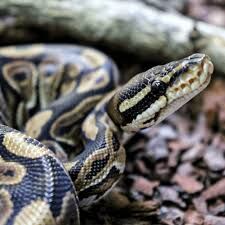The Royal Python earned its noble name because African rulers and royalty once adorned themselves with these snakes, draped over their shoulders or arms. Cleopatra herself was said to frequently wear a Royal Python wrapped around her wrist.
With their calm and friendly nature, these docile serpents make excellent pets and enjoy being held.
Also known as the Ball Python, this name comes from their instinct to curl into a tight ball when feeling threatened.
Slow and Stealthy Hunters
While Royal Pythons have a top speed of just 1.5 km/h, they don’t rely on speed. Instead, they are patient and opportunistic hunters, lying in wait to strike and ambush their prey.
A Kaleidoscope of Beauty
Their natural skin showcases stunning shades of copper, dark mustard yellow, and black camouflage. However, breeders have developed many morphs, resulting in a dazzling variety of colors and patterns. Every python has a unique pattern, like a fingerprint.
Longevity and Size
These pythons can live 20–30 years, and the oldest recorded lived to an impressive 62 years!
They are among the smallest python species, typically growing 4–6 feet long and weighing up to 6 pounds.
In comparison:
- The Reticulated Python is the longest snake, with one recorded at a jaw-dropping 33 feet and nearly 500 pounds!
- The Burmese Python is another enormous species, known for its sheer size and strength.
An Extra Sense
Pythons, along with vipers and boas, possess pit organs—tiny holes located near their mouths. These organs contain a membrane that detects infrared radiation from warm-blooded mammals up to half a meter away. This incredible adaptation gives them a unique “sixth sense” for hunting.
Whether admired for their regal history, calm demeanor, or fascinating biology, Royal Pythons are truly remarkable creatures with a legacy as majestic as their name.







